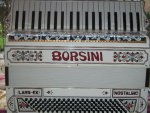wirralaccordion
Well-known member
- Joined
- Mar 22, 2017
- Messages
- 699
- Reaction score
- 400
How do you know how many voices/sets of reeds there are in vintage piano accordions where there is only one sound, i.e. there are no registers/couplers on the treble keyboard to allow the sound to be changed and none under the treble keyboard either where you would switch the sound with your wrist.
Are such piano accordions still being made today?
Are such piano accordions still being made today?

